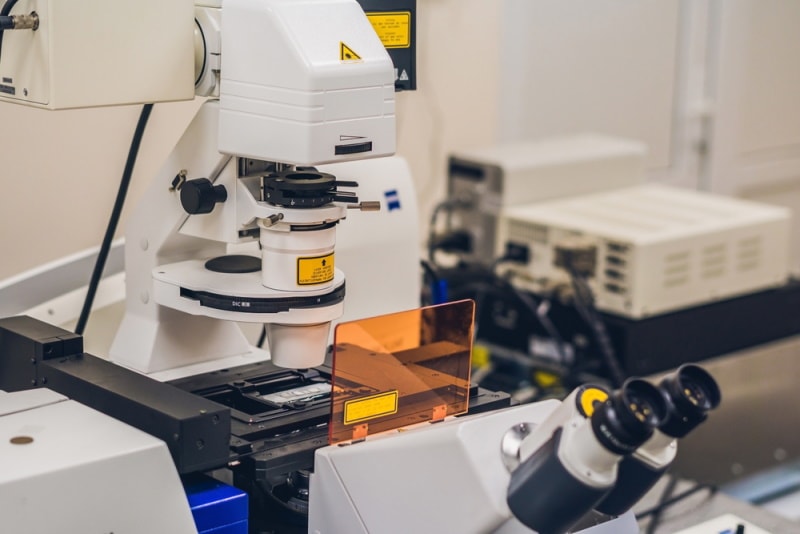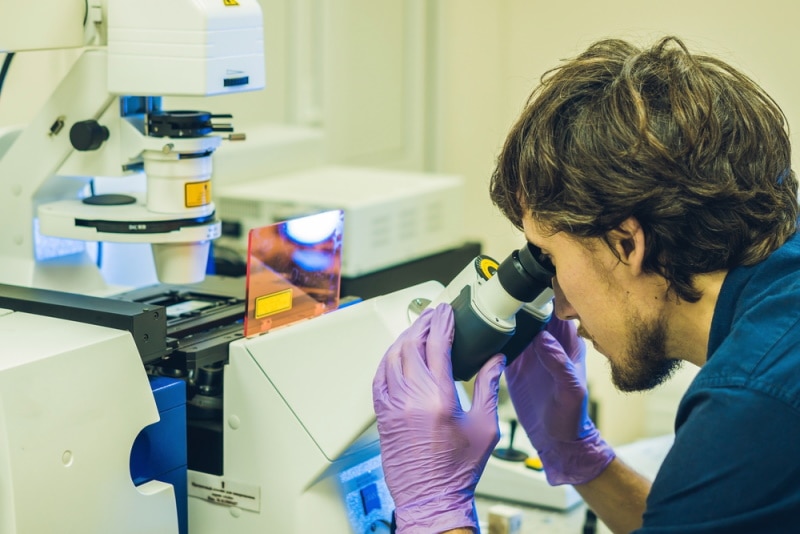What Is Confocal Microscopy Used For? The Interesting Answer!
Last Updated on

Confocal microscopy has become an important tool in the life sciences. It allows researchers to obtain high-resolution images of living cells and tissues, making it a valuable tool for studying the structure and function of biological systems. Confocal microscopy uses a laser to scan a specimen and create an image.
In this guide, I’ll discuss what confocal microscopy is, how it works, and what it’s used for. I’ll also provide a brief overview of its advantages and disadvantages.

How Does It Work?
Confocal microscopy works by using a laser to scan the specimen and create an image. The laser beam is focused on a small point of the specimen and then scanned across the surface. The light that is reflected back is then collected by a detector and used to create an image.
The main advantage of confocal microscopy is that it can produce very high-resolution images. This is because the laser beam is focused on a very small point, which means that only a small area of the specimen is illuminated at any one time. This also means that there is very little background light, which can make it difficult to see details in other types of microscopes.
Confocal microscopes can be used to look at a wide range of specimens, including cells, tissues, and even whole organisms. They are often used in medical research to study diseases such as cancer.

What Are the Different Types of Confocal Microscopy?
There are three main types of confocal microscopy, each with its own unique applications:
Spinning Disk Confocal Microscopy
This type of confocal microscope is best suited for live cell imaging applications. It uses a spinning disk to quickly scan the sample, allowing for high-speed imaging with minimal photodamage to the cells.
Programmable Array Microscopy (PAM)
PAM is ideal for imaging large areas of tissue or for looking at multiple samples simultaneously. It uses an array of optical fibers to illuminate the sample and capture images from multiple angles.
Laser Scanning Confocal Microscopy
This is the most common type of confocal microscope, and it can be used for a variety of applications. Laser scanning confocal microscopes use a laser to scan the sample, which allows for high-resolution images.
Each type of confocal microscope has its own strengths and weaknesses, so it’s important to choose the right one for your specific application.
Please note: Some confocal microscopes may be able to perform more than one type of confocal microscopy, depending on the specific model. As such, it’s always best to consult with a microscopy expert to find the right microscope for your needs.
Where Is It Used?
There are many fields where confocal microscopy is used. These include:
Biology
Scientists and researchers often use confocal microscopes to study cells and tissues. The high level of detail afforded by these microscopes means that they can learn a great deal about how the cells and tissues work. This knowledge can be used to develop new treatments for diseases or to understand the mechanisms behind them.

Biochemistry
Confocal microscopes are also used in biochemistry for tasks such as studying the structure of proteins. They can be used to study the way that proteins interact with other molecules and to work out the 3D structure of proteins.
Cell Biology
Confocal microscopes are widely used in cell biology. They can be used to study the structure of cells and to track the movement of cells and organelles within cells. They can also be used to study the interaction between cells and to look at the effects of drugs and other treatments on cells.
Developmental Biology
Confocal microscopes are also used in developmental biology. They can be used to study the development of embryos and to track the movement of cells during development.
Neuroscience
Thanks to the high-resolution images that confocal microscopes can provide, they have become an invaluable tool in the field of neuroscience. Researchers use them to study the structure and function of neurons, as well as neural circuits.
Confocal microscopy has also been used to create 3D reconstructions of brain tissue. These models can be used to study brain development and disease.

Materials Science
In materials science, confocal microscopy is used to study the surface of materials. It can be used to study how a material interacts with its environment, how it degrades over time, and how it responds to different types of stimuli.
Confocal microscopy can also be used to study the structure of materials at the nanoscale. This is important for understanding how materials behave at the atomic and molecular levels.
Advantages of Confocal Microscopy
Confocal microscopy has many advantages over traditional microscopy techniques. These include the following:
- Increased Resolution: Confocal microscopes can achieve a much higher level of resolution than traditional microscopes. This is because they use lasers to focus light on a specific point rather than using lenses.
- Reduced Blur: Because confocal microscopes use lasers to focus light, the images they produce are less blurry than those produced by traditional microscopes.
- Increased Contrast: Confocal microscopes can also produce images with increased contrast. This is because they can be used to selectively illuminate different parts of a sample.
- Increased Depth of Field: Another advantage of confocal microscopy is that it has a greater depth of field than traditional microscopy. This means that it can be used to view objects that are further away from the microscope.

Disadvantages of Confocal Microscopy
While there are numerous advantages to using confocal microscopy, there are also a few disadvantages that should be considered.
- Can Be Expensive: Confocal microscopes can be expensive, with some models costing over $100,000. This high price tag is due to the sophisticated nature of the instrument, which uses a laser to produce the images.
- Requires Expertise to Use: Confocal microscopes are not easy to use and require someone with experience and training to operate them. This can make it difficult for scientists who are not experts in the field to use this type of microscope.
- Time-Consuming: Creating confocal images can be a time-consuming process, as each image is created by scanning a sample with a laser beam. This can make the imaging process much slower than other types of microscopies.
Frequently Asked Questions (FAQs)
What is confocal microscopy?
Confocal microscopy is a type of scanning optical microscopy. It captures in-focus images from specific depths within thick specimens by using a pinhole to exclude out-of-focus light or glare. This results in three-dimensional images with high contrast and resolution.
What are the benefits of confocal microscopy?
The main benefit of confocal microscopy is that it provides clear and detailed three-dimensional images of thick specimens. Other benefits include its ability to capture fast-moving processes and its relatively low cost compared to other imaging techniques such as electron microscopy.

What are some applications of confocal microscopy?
Confocal microscopes are used in a variety of fields, including biology, medicine, and materials science. They are often used to study cells, tissues, and organs. In biology, they can be used to study the structure and function of proteins.
In medicine, they can be used to diagnose diseases such as cancer. In materials science, they can be used to study the properties of materials such as semiconductors.
What are the limitations of confocal microscopy?
The main limitation of confocal microscopy is its limited depth of field. This means that only a small part of the specimen can be in focus at any given time. Additionally, specimens must be relatively flat in order to produce clear images. Finally, confocal microscopy is not well suited for imaging moving objects.

Final Thoughts
Confocal microscopy is an important tool in many different scientific fields. Its ability to produce high-resolution, 3D images makes it ideal for studying cells and other small structures. Additionally, its use of lasers makes it possible to study living cells without causing damage.
Because of these capabilities, confocal microscopy is used in a variety of research areas, including cell biology, developmental biology, neuroscience, and cancer research. Thanks to its many applications, confocal microscopy is a powerful tool that scientists can use to gain a better understanding of the world around us.
Featured Image Credit: Elizaveta Galitckaia, Shutterstock
About the Author Robert Sparks
Robert’s obsession with all things optical started early in life, when his optician father would bring home prototypes for Robert to play with. Nowadays, Robert is dedicated to helping others find the right optics for their needs. His hobbies include astronomy, astrophysics, and model building. Originally from Newark, NJ, he resides in Santa Fe, New Mexico, where the nighttime skies are filled with glittering stars.
Related Articles:
What Is the Best Binocular Magnification for Hunting? Optical Features Explained
How to Clean a Refractor Telescope: Step-by-Step Guide
How to Clean a Telescope Eyepiece: Step-by-Step Guide
How to Clean a Rifle Scope: 8 Expert Tips
Monocular vs Telescope: Differences Explained (With Pictures)
What Is a Monocular Used For? 8 Common Functions
How to Clean a Telescope Mirror: 8 Expert Tips
Brightfield vs Phase Contrast Microscopy: The Differences Explained
